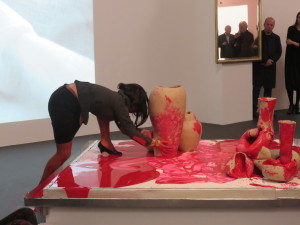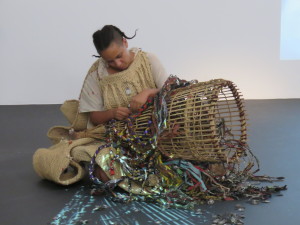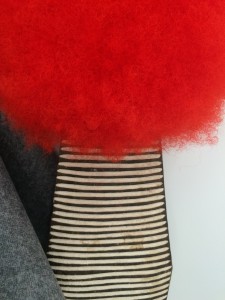
“(…)this exhibition shows six strong female African artists who, by using the body in different ways, express powerful messages. Their messages cover personal victories and visions on femininity, knowing one’s identity through one’s history, reflections on stereotypical thinking, healing the wounds of history by subverting one’s own body and reflections on the pain and alienation of being separated from one’s true identity. “
Rosalie van Deursen on body politics in the work of six female artists from Africa.
Marcia Kure, The Three Graces, detail, 2014
Body Politics in African Women’s Art
“I have a naïve dream about a perfect world. But it is not perfect yet and so unfortunately we still need exhibitions about female artists, and in this case female African artists.” – Koyo Kouoh.
Koyo Kouoh, a Cameroonian woman based in Senegal, is the guest curator of ‘Body Talk: Feminism, Sexuality and the Body in the Work of Six African Women Artists’ at the Contemporary Art Centre WIELS in Brussels. Her goal for this exhibition is on the one hand to raise the profile of female African artists and on the other to explore the body as a mindscape or territory for investigation.
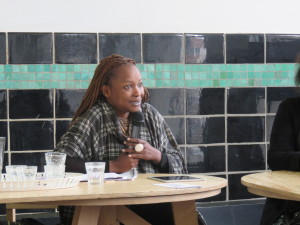
Koyo Kouoh, Curator
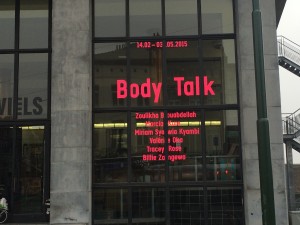 Wiels Building
Wiels Building
Lack of interest from the West?
Koyo Kouoh: “I always thought that gender should not be an issue in art, but despite wishful thinking, female artists are still totally underrepresented in comparison to males, especially female artists of non-Western backgrounds.” According to Koyo this is the result of a lack of interest in the Western world for other cultures. She points out the shared history between Africa and Europe. “Europeans cannot say the African continent is too far from them”, Koyo states. Living in a world where we are one click away from everything, Koyo sees the problem not as one of accessibility but of a lack of engagement, perhaps due to fear or a reluctance to engage with territories that one is not familiar with. By curating an exhibition about contemporary female African artists in Europe, she hopes to raise awareness about these issues at a global level.
Not a feminist pamphlet
Even though the exhibition is called ‘Body Talk: Feminism, Sexuality and the Body’, it was not Koyo’s idea to see it as feminist critique per se or a pamphlet, but more as an interest in ‘body politics’. So looking at the body as a site of control or expression, a tool, artistic material, an object of desire, a place of submission, a fantasy, property, merchandise and so on. In other words, all the multiple forms and roles that the body can play in the discussion about sexuality and the black female body. The exhibition is rooted in these ideas. In the work of the female African artists selected for the exhibition, the body manifests itself as a model, support, subject and object.
Six female African artists
Koyo stresses that nowadays almost everything that is labelled ‘African’ is seen as a representation of the whole continent. “This is not the case in this exhibition; it is just an exhibition about six female artists from the African continent or diaspora and an exploration of the body.” The six female artists on show are: Valérie Oka, Miriam Syowia Kyambi, Marcia Kure, Billie Zangewa, Tracey Rose and Zoulikha Bouabdellah.
‘You really think because I’m black I fuck better?’: Valérie Oka
The question: ‘Tu crois vraiment que parce que je suis noire je baise mieux?’ is posed by the Ivorian artist Valérie Oka, using bright neon letters on the wall. The text hangs above a dinner table covered with leftovers and empty bottles that looks as if the guests have just recently departed. They have left their reactions to Valerie’s statement on the wall scribbled on the paper tablecloth. The scene is the result of a discussion performance entitled ‘In her presence’ in which Valérie invited twelve guests to come and explore the ramifications of her statement. She wants to open up the discussion about stereotypical thinking regarding the black female body and come to a better understanding of the embodiment of the black woman as sexual object. Although this artwork is specifically about the stereotypes of black sexuality she sees her work in a broader light. Valérie explains: “All of us are emotionally traumatized during our education and upbringing. I am interested in how people can perceive the same things, such as objects or ideas in a different way, but also how people can perceive different things, such as objects or ideas in the same way. How people experience things depends on their life experience and history and that’s fascinating to explore.”
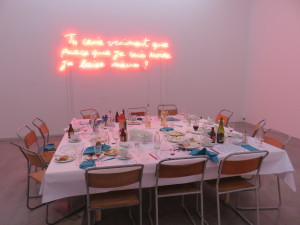 Valérie Oka, In her presence, 2015.
Valérie Oka, In her presence, 2015.
Stereotypes
In another of Valerie’s performances that was held at the opening of the exhibition, she showed a big cage with an open door, containing a huge white penis and a naked black woman who strolled around the cage. She wants to address how black women are often perceived by white males as sexual objects. Valerie wants to raise awareness about how the black body is objectified and stereotyped. Valérie: “I want people to experience the emotions coursing through them when looking at a naked black female body in an open cage with a white penis and ask themselves what is uncomfortable and why. Colonial stereotypes of black women as sexual objects are rooted in the imagination.” Valerie feels strongly that the effects of colonial thinking are still alive and kicking in the contemporary world.
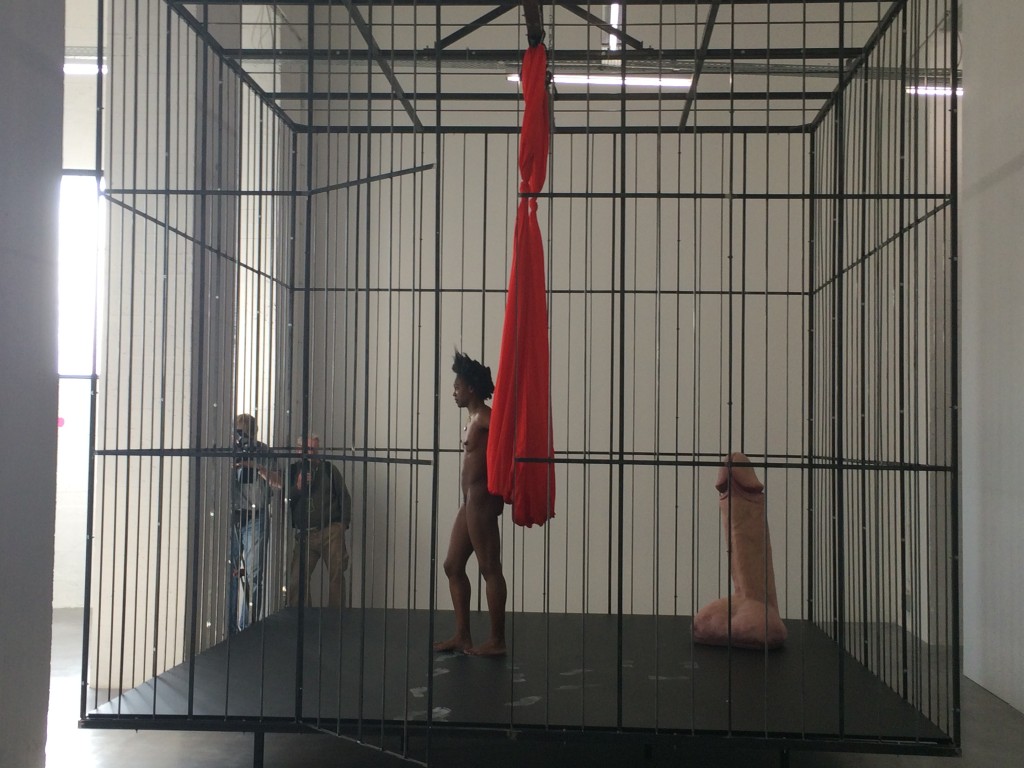 Valérie Oka, Untitled, 2015.
Valérie Oka, Untitled, 2015.
Coping with yourself: Miriam Syowia Kyambi
History and its effects on the present play a very important role in the works of all the artists in this exhibition. The Kenyan Miriam Syowia Kyambi made an installation and performance entitled ‘Fracture I’ in which she uses the female body as a tool to express her message. Rose is the main character in Miriam’s story, a woman who is steeped in doubt. She no longer knows where she belongs and is unable to cope with herself either within the context of the rural tradition or urban modernity.
Agony
Miriam’s performance starts with a figure in a sisal costume covered with beads. The sisal refers to colonial times in which the sisal factories were owned by colonisers as well as to a traditional weaving technique. The beads refer to trade. The figure destroys pots & vases full of blood causing the blood to flow freely. It represents the destruction of culture and traditional life in Kenya but also self-destruction. “It’s a vicious character. It’s not in a human state of mind. The being interacts with the audience; intimidating them and looking for people to engage with who will allow themselves to be drawn in and become equally aggressive. The vases are a representation of a culture, of a practice, of people who get destroyed.” The figure evolves into the character Rose, someone from a rural area in upcountry Kenya moving into the city where she tries to deal with city life and capitalism.
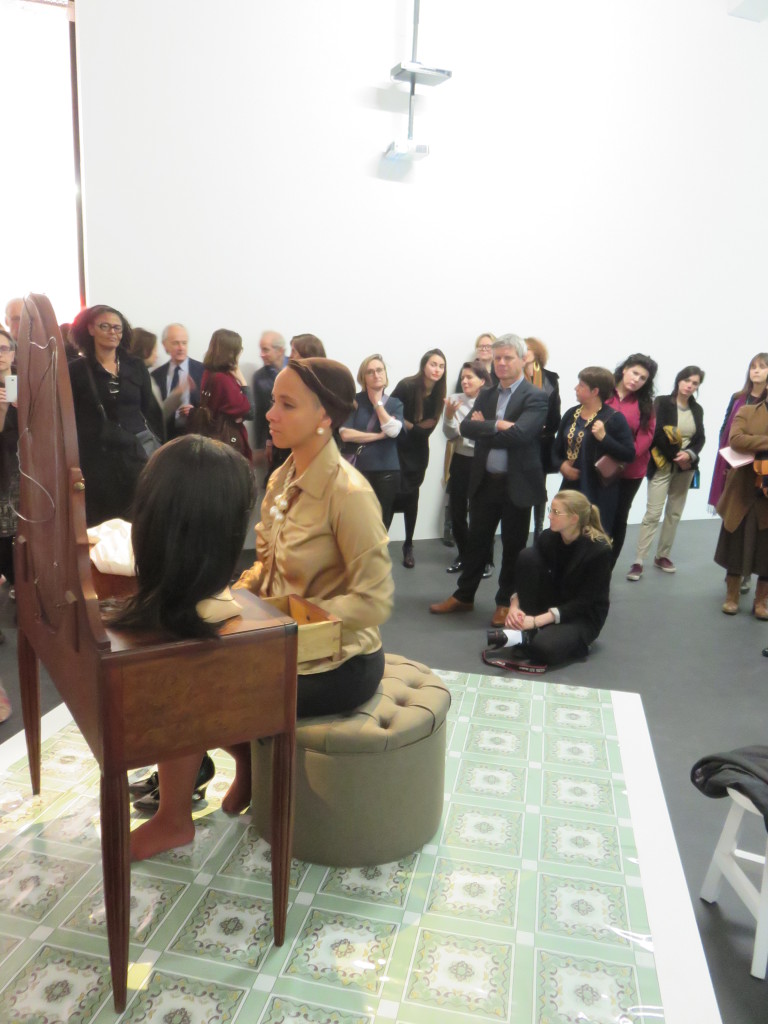 Miriam Kyambi, Fracture 1, Performance, 2011-2014.
Miriam Kyambi, Fracture 1, Performance, 2011-2014.
Living the perfect life
Rose has the mind-set of a successful consumer and tries to lead the perfect modern life with a two-storey house, a husband, two children a job and a car. During the performance Rose gets ready for her day but she keeps failing to cope. She falls down repeatedly and mourns the past and tries to reassemble the broken pots and vases. She stumbles over the remains of her past destruction and finally faces the losses of the past and gives up the role she has created for herself. Miriam explains: “Acknowledging that destruction is a very important step in the reparation process. If you understand your history, than you understand the present day relationships and circumstances better.”
Miriam Kyambi, Fracture 1, Performance, 2011-2014.
Finally Rose becomes the artist who suspends the sisal costume in front of a mirror and the mirror then reflects the audiences and integrates them into her performance. Miriam: “The work is layered and has more than one purpose. It has more than one narrative, because the things that influence me come from many sources. People can connect to my work in different ways. It can be read as a woman who is confined but people can also relate to the colonial history. Both stories are totally relevant.”
Seeking for identity: Marcia Kure
The Nigerian Marcia Kure related strongly to Miriam Syowia Kyambi’s work. Marcia: “I was deeply moved, because I saw myself! It’s a struggle to find your identity. Knowing your history is very important in that process. You have to take care of your legacy.” Connecting with her past enables Marcia to understand herself better and is a source of power for her. In Marcia’s work ‘The Three Graces’, she refers to the brave and strong Amazonian warriors of the kingdom of Dahomey, Nandi, the mother of the legendary 19th century Zulu king Shaka and Olufunmilayo Kuti, the Nigerian activist and mother of the famous Afrobeat musician Fela Kuti.
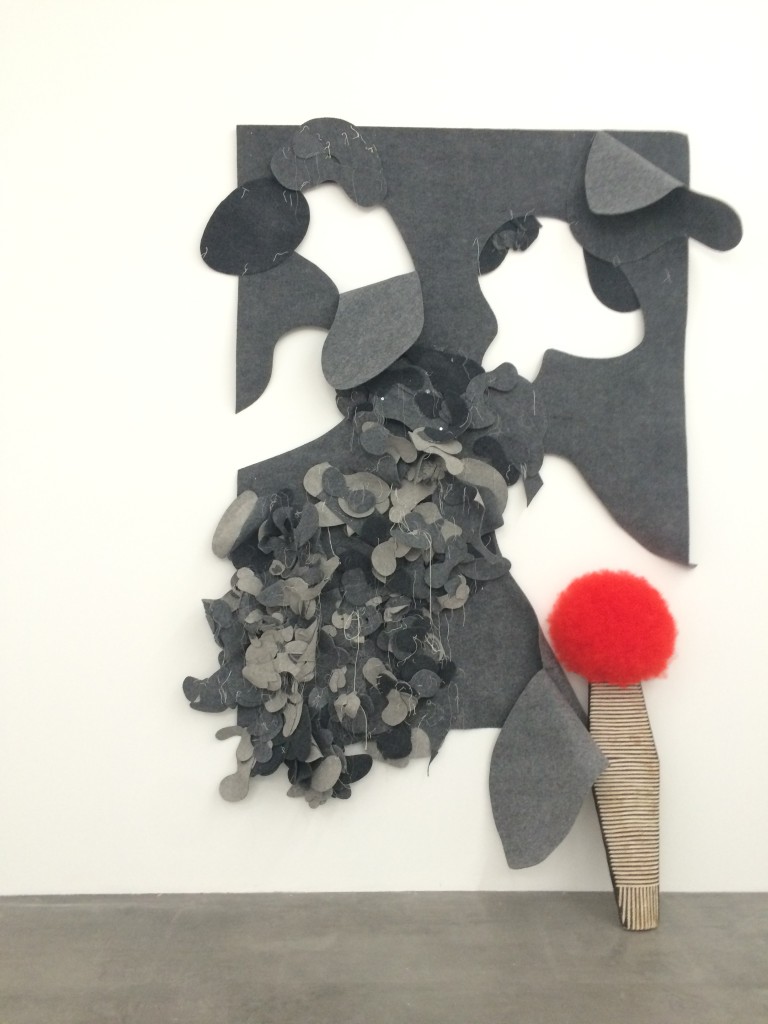
Marcia Kure, Three Graces, 2014.
Amazonian warrior
Her Amazonian warriors are represented in a sculptural installation full of metaphors. Frayed carpet is the skin of the female body, fragile but resilient. Brightly-coloured Afro wigs emphasise the pride of having curly African hair. The wooden shields with minimalistic incisions are reminders of the beauty marks of a rite de passage on the bodies of African women. Marcia seems to present herself like an Amazonian warrior. She wears a mask over her eyes, metallic gloves yet very feminine and alluring clothes. The effect is to create a proud, womanly and militant presence.
 Marcia Kure
Marcia Kure
Finding your own story
Marcia: “We are disconnected from our past but you can’t force anyone to attempt to rediscover that connection.” Even though it’s difficult, she loves to pass on her message to a larger community of young black girls. “I want to inspire them, so they will also find out who they really are and start looking for their own stories… So they can feel more grounded and connected. It all started with my own daughter and I was thinking that I need to help her to build her identity, to know who she is.” Knowing one’s history makes one more proud of oneself, according to Marcia Kure.
Ode to femininity: Billie Zangewa
The South African Billie Zangewa also makes work as an ode to femininity. Billie‘s collages are made with pieces of silk and represent the urban self-confident woman who is gracefully thin, well-educated, eco-conscious and with a high sense of self-esteem. Her work is mostly autobiographical and she wants to show a positive vision of womanhood instead of simply criticising men. She finds it more effective to be subtle than to be an extreme feminist. Her ‘silk tapestries’ are self-explorations, from questioning to acceptance; it’s her personal journey that is shown through the traditional female craft of sewing. Billie explains: “It’s like I am going on a date with myself. It’s a journey of self-discovery and I am asking myself how I feel, what I think about my life. It’s a beautiful experience that I feel the need to share, because I feel these are global experiences and I am not alone in that. So I give you Billie, it’s what I want to share and say.”
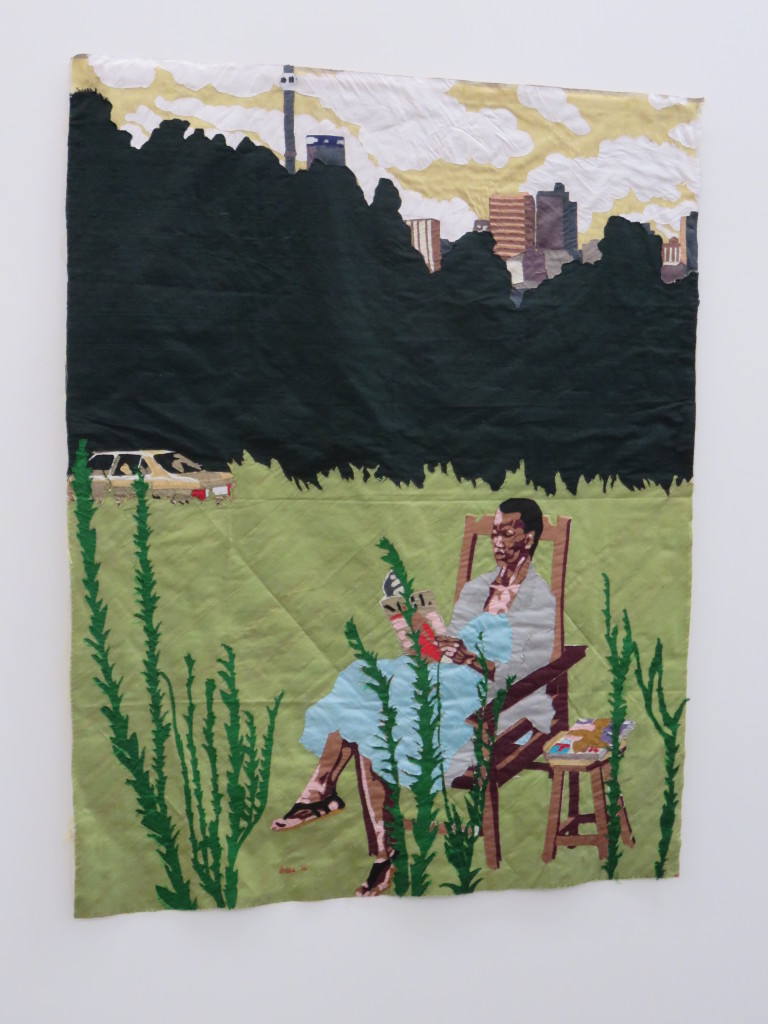 Billie Zangewa, Exquisite Fantasy, 2014
Billie Zangewa, Exquisite Fantasy, 2014
‘Surrender whole-heartedly to your complexity’
Billie’s work ‘Rebirth of the Black Venus’ is iconic and represents the return or triumph of self-assurance and self-empowerment. It is a reference to Botticelli’s Venus, but now she rises from the city of Johannesburg instead of from a sea-shell. She has the status of a goddess and stresses the power that one can experience by knowing, embracing and loving oneself. Billie: “I tell the story of a female protagonist in an urban setting. It’s symbolic of a general state of being but biographical because I draw the information from my own experiences.” On the body of the black Venus is a sash with the words ‘Surrender whole-heartedly to your complexity’.
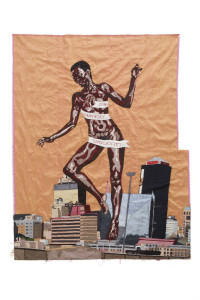 Billie Zangewa, The Rebirth oft he Black Venus, 2010.
Billie Zangewa, The Rebirth oft he Black Venus, 2010.
Billie: “Have compassion for yourself, no one is perfect. I started to acknowledge the ‘not-so-great-parts’ in myself, because we are flawed and perfect at the same time. Let’s talk about human things including our shame, let’s make it public! It’s a good thing for us to do as a society, to actually share and be compassionate towards each other. It helps to heal society.”
Subvert the notion of a black feminist body: Tracey Rose
The South African Tracey Rose is also inspired by the desire to heal society and made a site-specific video entitled ‘Tracings’. She started with a walking performance through Brussels which is a pilgrimage to King Leopold II’s grave. At the cemetery Tracey put the late King on symbolic trial for the horrors he had committed in Africa. Tracey explains: “I wanted to take away my own body and dematerialize it. I wanted to subvert the notion of being a black feminist body. I see myself as a shaman, a healer in which art was my vehicle. ”
Accepting & contesting the world: Zoulikha Bouabdellah
The Moroccan artist Zoulikha Bouabdellah also works on dematerialization of the body, but only partially. She made a series of collages of nudes from posters of famous 19th century French and Spanish paintings. Each one of them can be seen from two angles: the figurative nudes from the famous paintings or the abstract compositional patterns of oriental rugs that she integrates the posters into. Her source of inspiration is Albert Camus’ work ‘The Wrong Side and the Right Side’. She uses division, two different approaches to make two images in one: one figurative and the other abstract. In other words, the ambivalence between accepting or contesting the world, between the wrong and the right side.
 Zoulikha Bouabdellah, Nu
Zoulikha Bouabdellah, Nu
Powerful messages
To conclude, this exhibition shows six strong female African artists who, by using the body in different ways, express powerful messages. Their messages cover personal victories and visions on femininity, knowing one’s identity through one’s history, reflections on stereotypical thinking, healing the wounds of history by subverting one’s own body and reflections on the pain and alienation of being separated from one’s true identity.
Breaking old patterns
One thing all the artists have in common is the belief that no matter how you see yourself or the world, it’s in your own hands to make a change or to see things from a different perspective. Koyo Kouoh: “Breaking old patterns begins with oneself.” By curating this exhibition Koyo Kouoh shows that she is willing to invest in her dream to make the world more perfect. By bringing these six female African artists together she provides a platform to exhibit both their strengths & vulnerabilities. But it’s more than just an exhibition; as Miriam Syowia Kyambi says: “This exhibition is a gathering of female power and a place for inspiration, self-discovery and acceptance. Even though we work in isolation, we are not in solitude. By meeting each other a network is being created. And hopefully we can go beyond being presented as an African art exhibition, because art is art!”

